The Flue Gas Desulphurization Market is estimated to be valued at USD 21.7 billion in 2025 and is projected to reach USD 29.2 billion by 2035, registering a compound annual growth rate (CAGR) of 3.0% over the forecast period.
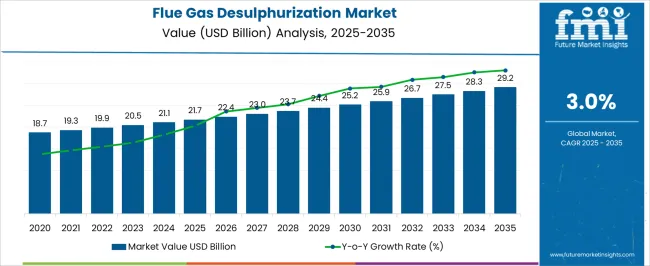
| Metric | Value |
|---|---|
| Flue Gas Desulphurization Market Estimated Value in (2025 E) | USD 21.7 billion |
| Flue Gas Desulphurization Market Forecast Value in (2035 F) | USD 29.2 billion |
| Forecast CAGR (2025 to 2035) | 3.0% |
The flue gas desulphurization market is experiencing steady growth, driven by increasing environmental regulations and stringent emission standards in major industrial regions. Rising global demand for cleaner air and reduced sulfur dioxide emissions is influencing utility operators and industrial facilities to adopt effective desulphurization technologies. Investments in power generation infrastructure, particularly coal-fired and oil-fired plants, are supporting the installation of advanced flue gas desulphurization systems.
Technological advancements in absorber design, reagent handling, and process efficiency are enhancing operational reliability and reducing maintenance requirements. Governments worldwide are enforcing compliance with environmental policies, which encourages retrofitting of existing plants with advanced systems and drives adoption in new installations.
The growing emphasis on reducing acid rain, improving air quality, and meeting carbon and sulfur emission targets is creating long-term opportunities for the market Increasing industrialization in emerging economies is further stimulating demand for large-scale installations, ensuring that the market maintains a positive growth trajectory over the next decade.
The flue gas desulphurization market is segmented by type, application, and geographic regions. By type, flue gas desulphurization market is divided into Wet FGD System and Dry and Semi-dry FGD System. In terms of application, flue gas desulphurization market is classified into Power Generation, Manufacturing Plants, Chemical Industries, Iron and Steel, and Others. Regionally, the flue gas desulphurization industry is classified into North America, Latin America, Western Europe, Eastern Europe, Balkan & Baltic Countries, Russia & Belarus, Central Asia, East Asia, South Asia & Pacific, and the Middle East & Africa.
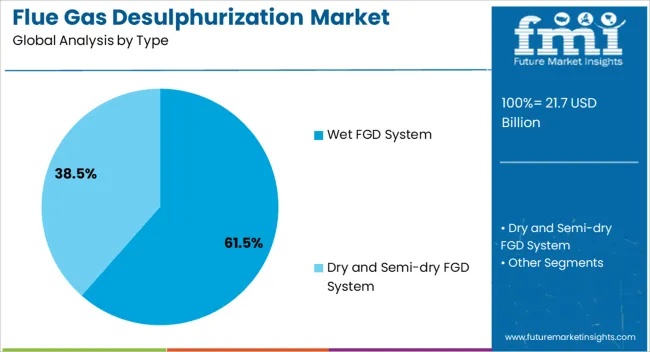
The wet FGD system type segment is projected to hold 61.5% of the flue gas desulphurization market revenue share in 2025, making it the leading technology type. This dominance is being driven by its high efficiency in removing sulfur dioxide and other acidic gases from flue emissions, ensuring compliance with stringent environmental regulations.
Wet systems are preferred for large-scale power plants and industrial facilities due to their ability to handle high gas volumes and variable sulfur content effectively. The segment is supported by technological innovations in absorber design, reagent recirculation, and waste byproduct management, which enhance operational reliability and reduce overall lifecycle costs.
Wet FGD systems are also being favored for their capability to achieve higher sulfur removal rates compared to dry or semi-dry alternatives, which is critical for plants operating under strict emissions standards Growing emphasis on reducing air pollution and meeting sustainability targets is reinforcing the adoption of wet FGD systems, solidifying their market leadership in the global flue gas desulphurization market.
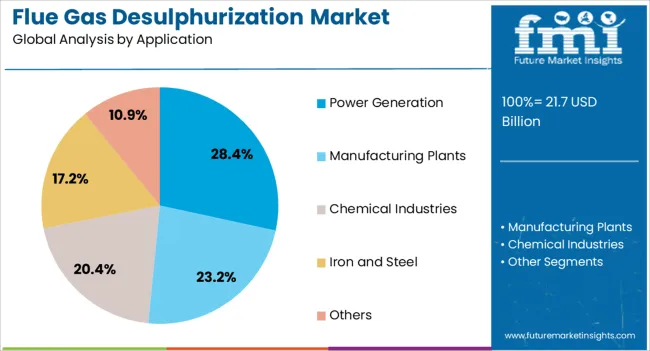
The power generation application segment is expected to account for 28.4% of the flue gas desulphurization market revenue share in 2025, positioning it as the leading application area. This leadership is being driven by the widespread adoption of coal-fired power plants and the growing need for retrofitting older facilities to comply with stricter emissions regulations.
Flue gas desulphurization systems in power generation reduce sulfur dioxide emissions, helping plants meet both national and international air quality standards. Increasing environmental awareness, coupled with governmental incentives and penalties related to emissions, is influencing plant operators to invest in high-efficiency FGD technologies.
The segment is further supported by technological improvements that reduce operational costs, improve reagent utilization, and facilitate waste byproduct management As the global power sector faces rising pressure to lower environmental impact while maintaining high energy output, the deployment of flue gas desulphurization systems is expected to remain a priority, sustaining growth for this application segment over the next decade.
The global flue gas desulphurization market is expected to register a CAGR of 3% during the forecast years of 2025 and 2035. The growing need to fight the air pollution battle has boosted the demand for flue gas desulphurization (FGD) systems.
Stringent national and international laws to install air filtration units in places that emit Sulphur dioxide (SO2) are expected to key drivers for this market in the next decade. All the prominent industrialized nations around the globe have formulated regulations concerning mitigation of carbon and sulphur dioxide emissions as maintaining global temperature gained spotlight.
Rapid industrialization and concentration of manufacturing activities in Asia Pacific has created a serious need for implementation of FGD technology to reduce emissions. In addition, exponential usage of electricity, rise of coal-fired operations, especially in China and India are expected to give this market a shot in the arm.
In the wake of recent pandemic, the focus on seeking solutions for climate change is going to draw attention to every solution for reducing emissions. Thus, as economies begin to recovers, nations will make a hurried investment in FGD technology to make air cleaner, avert chances of acid rain due to particles of nitrogen and sulphur, and better temperature conditions.
On the basis of type, the FGD market can be segmented into dry and semi-dry FGD system and wet FGD system. Analysts expect that the wet FGD segment will pace ahead as it highly efficient and is thus found in majority of the industrial units. As coal-fired plants are biggest contributors of flue gases, it is mandatory to ensure efficient systems to ensure clean coal energy generation. This is expected to keep wet FGDs segment in the lead in the coming decade.
The key end users of FGD technology are manufacturing plants, chemical industries, iron and steel industries, power generation, and others. The power generation segment is expected to assume lead as demand for electricity and power continues to be relentless in developing economies.
Economies focussing on manufacturing will continue to demand high energy generation, which in turn will feed the demand for FGD technology during the forecast period.
In terms of region, Asia Pacific is expected to exhibit a steady growth during the forecast period. In an earlier forecast though India and China presented incredible opportunity, the focus is now shifting from China. Manufacturing units are looking at shifting base from China to Japan and India as the world tries to cope with COVID-19 pandemic.
As coal continues to be a cheap source of energy in developing economies, the rise of manufacturing will be Asia Pacific’s way ahead in the global economy. This in turn will keep the regional ahead as the economy recovers.
In the coming years, containing emissions, cleaner air, and a lesser negative impact on environment are likely to be the key goals of any big company. Every nation will have to rework its strategies to recover of the ongoing 2025 recession while taking care of the environment.
Thus, the future of the FGD systems is a bright one. Analysts at FMI anticipate that the market will steadily recover and flourish as energy mixes alter. However, the players need to rethink of building their markets as alternative energy solutions will gain prominence.
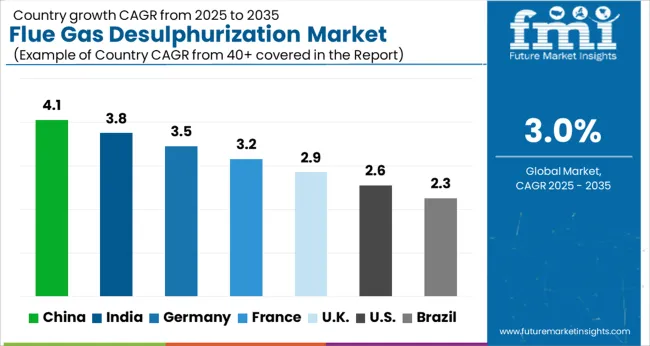
| Country | CAGR |
|---|---|
| China | 4.1% |
| India | 3.8% |
| Germany | 3.5% |
| France | 3.2% |
| UK | 2.9% |
| USA | 2.6% |
| Brazil | 2.3% |
The Flue Gas Desulphurization Market is expected to register a CAGR of 3.0% during the forecast period, exhibiting varied country level momentum. China leads with the highest CAGR of 4.1%, followed by India at 3.8%. Developed markets such as Germany, France, and the UK continue to expand steadily, while the USA is likely to grow at consistent rates. Brazil posts the lowest CAGR at 2.3%, yet still underscores a broadly positive trajectory for the global Flue Gas Desulphurization Market. In 2024, Germany held a dominant revenue in the Western Europe market and is expected to grow with a CAGR of 3.5%. The USA Flue Gas Desulphurization Market is estimated to be valued at USD 7.6 billion in 2025 and is anticipated to reach a valuation of USD 9.8 billion by 2035. Sales are projected to rise at a CAGR of 2.6% over the forecast period between 2025 and 2035. While Japan and South Korea markets are estimated to be valued at USD 1.1 billion and USD 589.1 million respectively in 2025.
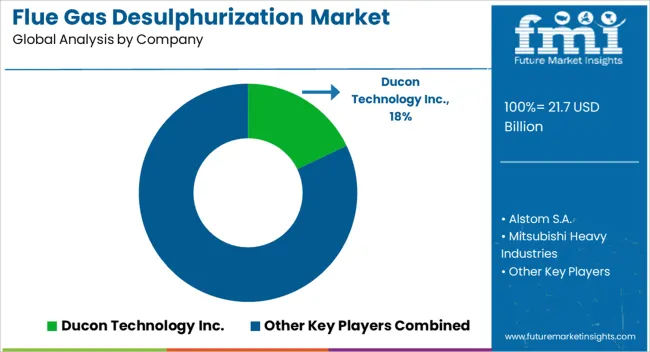
| Item | Value |
|---|---|
| Quantitative Units | USD 21.7 Billion |
| Type | Wet FGD System and Dry and Semi-dry FGD System |
| Application | Power Generation, Manufacturing Plants, Chemical Industries, Iron and Steel, and Others |
| Regions Covered | North America, Europe, Asia-Pacific, Latin America, Middle East & Africa |
| Country Covered | United States, Canada, Germany, France, United Kingdom, China, Japan, India, Brazil, South Africa |
| Key Companies Profiled | Ducon Technology Inc., Alstom S.A., Mitsubishi Heavy Industries, Siemens Energy, Wilcox, Marsulex Environmental Technologies, and Babcock |
The global flue gas desulphurization market is estimated to be valued at USD 21.7 billion in 2025.
The market size for the flue gas desulphurization market is projected to reach USD 29.2 billion by 2035.
The flue gas desulphurization market is expected to grow at a 3.0% CAGR between 2025 and 2035.
The key product types in flue gas desulphurization market are wet fgd system and dry and semi-dry fgd system.
In terms of application, power generation segment to command 28.4% share in the flue gas desulphurization market in 2025.






Our Research Products

The "Full Research Suite" delivers actionable market intel, deep dives on markets or technologies, so clients act faster, cut risk, and unlock growth.

The Leaderboard benchmarks and ranks top vendors, classifying them as Established Leaders, Leading Challengers, or Disruptors & Challengers.

Locates where complements amplify value and substitutes erode it, forecasting net impact by horizon

We deliver granular, decision-grade intel: market sizing, 5-year forecasts, pricing, adoption, usage, revenue, and operational KPIs—plus competitor tracking, regulation, and value chains—across 60 countries broadly.

Spot the shifts before they hit your P&L. We track inflection points, adoption curves, pricing moves, and ecosystem plays to show where demand is heading, why it is changing, and what to do next across high-growth markets and disruptive tech

Real-time reads of user behavior. We track shifting priorities, perceptions of today’s and next-gen services, and provider experience, then pace how fast tech moves from trial to adoption, blending buyer, consumer, and channel inputs with social signals (#WhySwitch, #UX).

Partner with our analyst team to build a custom report designed around your business priorities. From analysing market trends to assessing competitors or crafting bespoke datasets, we tailor insights to your needs.
Supplier Intelligence
Discovery & Profiling
Capacity & Footprint
Performance & Risk
Compliance & Governance
Commercial Readiness
Who Supplies Whom
Scorecards & Shortlists
Playbooks & Docs
Category Intelligence
Definition & Scope
Demand & Use Cases
Cost Drivers
Market Structure
Supply Chain Map
Trade & Policy
Operating Norms
Deliverables
Buyer Intelligence
Account Basics
Spend & Scope
Procurement Model
Vendor Requirements
Terms & Policies
Entry Strategy
Pain Points & Triggers
Outputs
Pricing Analysis
Benchmarks
Trends
Should-Cost
Indexation
Landed Cost
Commercial Terms
Deliverables
Brand Analysis
Positioning & Value Prop
Share & Presence
Customer Evidence
Go-to-Market
Digital & Reputation
Compliance & Trust
KPIs & Gaps
Outputs
Full Research Suite comprises of:
Market outlook & trends analysis
Interviews & case studies
Strategic recommendations
Vendor profiles & capabilities analysis
5-year forecasts
8 regions and 60+ country-level data splits
Market segment data splits
12 months of continuous data updates
DELIVERED AS:
PDF EXCEL ONLINE
Flue Gas Coolers Market Size and Share Forecast Outlook 2025 to 2035
Flue Gas Desulfurization System Market Analysis - Size, Share & Forecast 2025 to 2035
Flue Gas Analyzer Market
Gas Insulated Switchgear (GIS) Bushing Market Size and Share Forecast Outlook 2025 to 2035
Gas Discharge Tube (GDT) Arresters Market Size and Share Forecast Outlook 2025 to 2035
Gas & Dual-Fuel Injection Systems Market Size and Share Forecast Outlook 2025 to 2035
Gas Desiccant Dehydration Unit Market Size and Share Forecast Outlook 2025 to 2035
Gas Cylinder Market Size and Share Forecast Outlook 2025 to 2035
Gasket and Seal Market Size and Share Forecast Outlook 2025 to 2035
Gas Separation Membrane Market Size and Share Forecast Outlook 2025 to 2035
Gas Jet Compressor Market Size and Share Forecast Outlook 2025 to 2035
Gas Fired Water-Tube Food Processing Boiler Market Size and Share Forecast Outlook 2025 to 2035
Gas Fired Real Estate Generator Market Size and Share Forecast Outlook 2025 to 2035
Gastric-soluble Hollow Capsules Market Size and Share Forecast Outlook 2025 to 2035
Gas Cooling System Market Analysis - Size, Share, and Forecast Outlook 2025 to 2035
Gasoline Gensets Market Size and Share Forecast Outlook 2025 to 2035
Gas Insulated Smart Ring Main Unit Market Size and Share Forecast Outlook 2025 to 2035
Gas Turbine Oil Market Size and Share Forecast Outlook 2025 to 2035
Gas Telecom Generator Market Size and Share Forecast Outlook 2025 to 2035
Gas Insulated Ring Main Unit Market Size and Share Forecast Outlook 2025 to 2035

Thank you!
You will receive an email from our Business Development Manager. Please be sure to check your SPAM/JUNK folder too.
Chat With
MaRIA